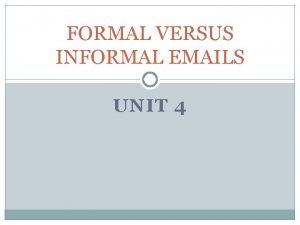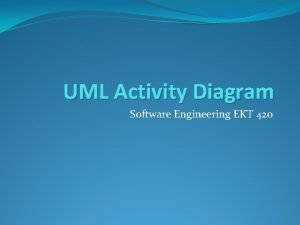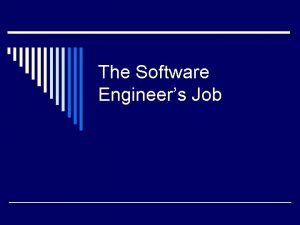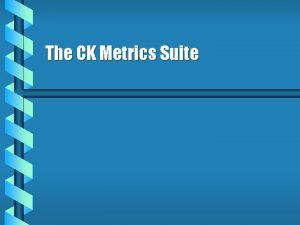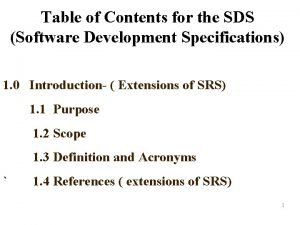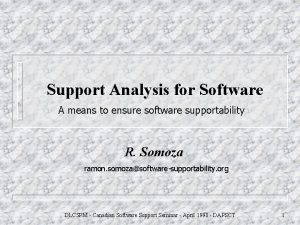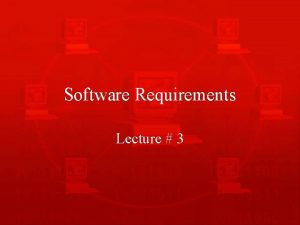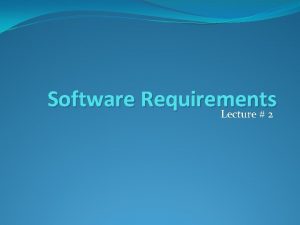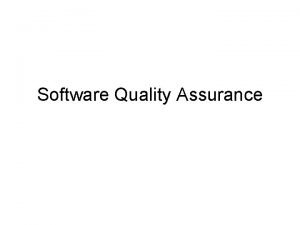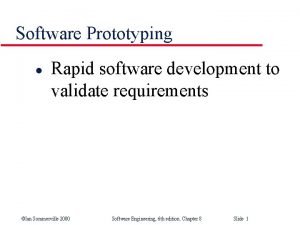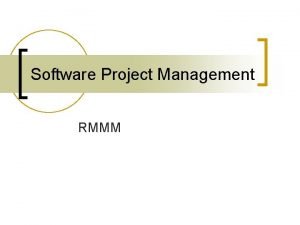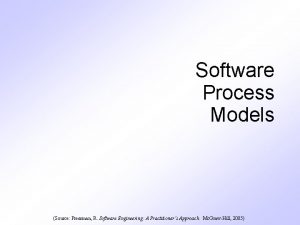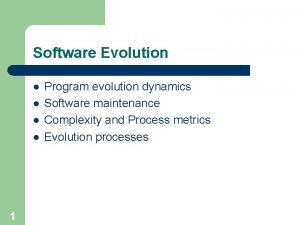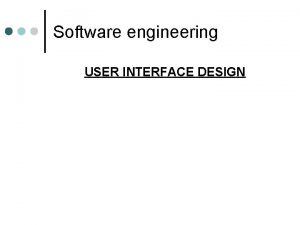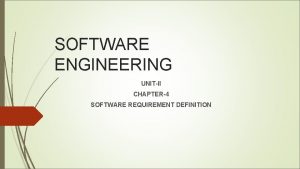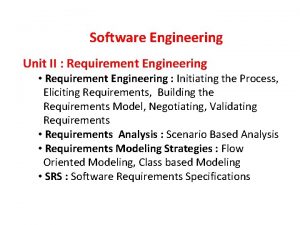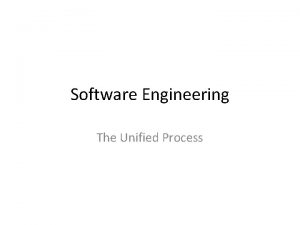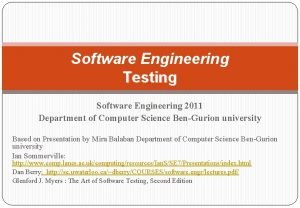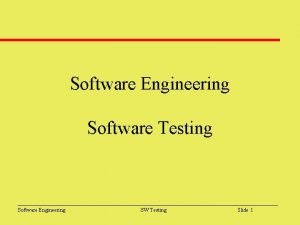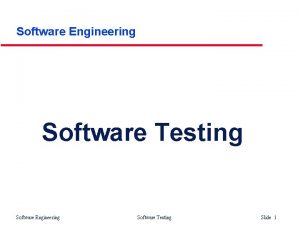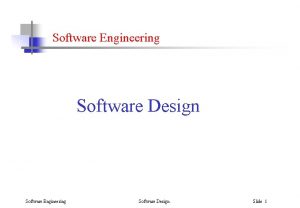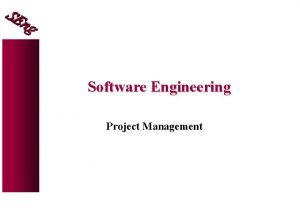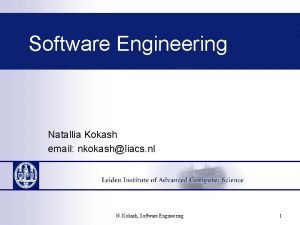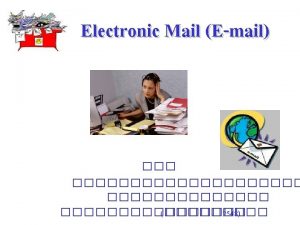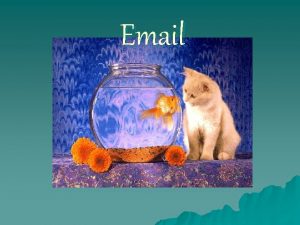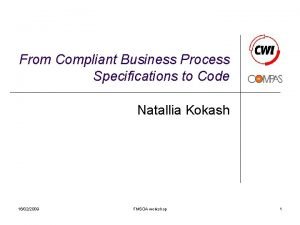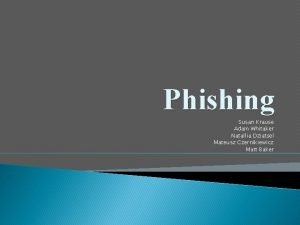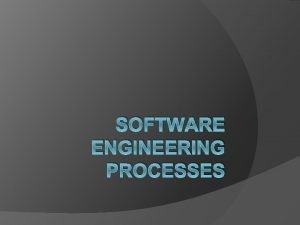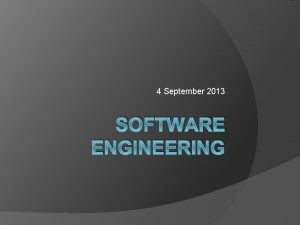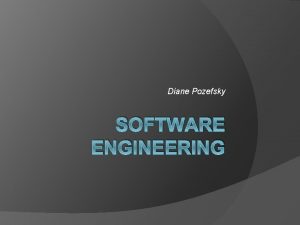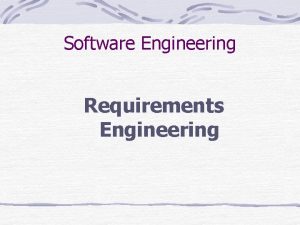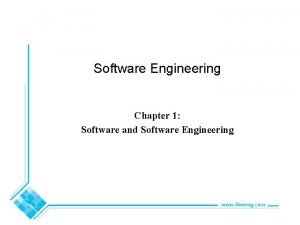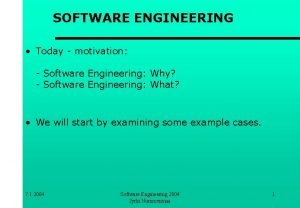Software Engineering Natallia Kokash email nkokashliacs nl 1








































- Slides: 40

Software Engineering Natallia Kokash email: nkokash@liacs. nl 1

Software Engineering Software maintenance n Definition n Software maintenance issues n Maintenance and evolution n Reverse engineering (refactoring, bad smells) n Program comprehension n Maintenance tools n Organization and control of maintenance 2

Software Engineering Need for software maintenance n n 100 billion lines of code 80% of it is unstructured, patched and badly documented n A multinational bank: n 100+ offices n 10+ mainframes at a central site n 1000+ workstations n 24 * 7 availability n 100+ application systems n 500 K+ LOC n Obsolete languages (Fortran, COBOL) n Huge databases 3

Software Engineering Definition The process of modifying a software system or component after delivery to: n Correct faults, n Improve performance or other attributes, or n Adapt to a changed environment 4

Software Engineering Distribution of maintenance activities corrective 21% perfective 50% adaptive 25% preventive 4% n n Corrective maintenance: correcting discovered errors Preventive maintenance: correcting latent errors Adaptive maintenance: adapting to changes in the environment Perfective maintenance: adapting to changing user requirements 5

Software Engineering Growth of maintenance problem 1975: ~75, 000 people in maintenance (17%) n 1990: 800, 000 (47%) n 2005: 2, 500, 000 (76%) n 2015: ? ? n (Numbers from Jones (2006)) 6

Software Engineering Maintenance or Evolution n Some observations: ¨ Systems are not built from scratch ¨ There is time pressure on maintenance ¨ Software is embedded in the real world and become part of it, thereby changing it. ¨ This leads to a feedback system where the program and its environment evolve in concert. 7

Software Engineering Laws of software evolution (Lehman 1974) n Continuing Change ¨ Programs must be continually adapted or they become progressively less satisfactory. n Increasing Complexity ¨ As a program evolves its complexity increases unless work is done to maintain or reduce it. n Self Regulation ¨ Evolution process is self regulating with distribution of product and process measures close to normal. 8

Software Engineering Illustration of the third law System attributes Self Regulation Evolution process is self regulating with distribution of product and process measures close to normal. Time 9

Software Engineering Laws of software evolution (Lehman 1974) n Conservation of Organizational Stability (invariant work rate) ¨ The average effective global activity rate in an evolving system is invariant over product lifetime n Conservation of Familiarity (incremental growth) ¨ As a system evolves all associated with it (e. g. , developers) must maintain mastery of its content and behavior to achieve satisfactory evolution. Excessive growth diminishes that mastery. 10

Software Engineering Laws of software evolution (… and later) n Continuing Growth ¨ The functional content of systems must be continually increased to maintain user satisfaction over their lifetime. n Declining Quality ¨ The quality of systems will appear to be declining unless they are rigorously maintained and adapted to operational environment changes. n Feedback System ¨ Evolution processes constitute multi-level, multi-loop, multi-agent feedback systems and must be treated as such. 11

Software Engineering Fighter plane control system IF not-read 1 (V 1) GOTO DEF 1; display (V 1); GOTO C; DEF 1: IF not-read 2 (V 2) GOTO DEF 2; display (V 2); GOTO C; DEF 2: display(3000) C: 12

Software Engineering Major causes of maintenance problems Unstructured code n Insufficient domain knowledge n Insufficient documentation n 13

Software Engineering Key to maintenance is in development n n Higher quality less (corrective) maintenance Anticipating changes less (adaptive and perfective) maintenance Better tuning to user needs less (perfective) maintenance Less code less maintenance 14

Software Engineering Shift in type of maintenance over time Introductory stage: emphasis on user support n Growth stage: emphasis on correcting faults n Maturity: emphasis on enhancements n Decline: emphasis on technology changes n 15

Software Engineering Reverse engineering n n Does not involve any adaptation of the system Akin to reconstruction of a blueprint Design recovery: result is at higher level of abstraction Redocumentation: result is at same level of abstraction 16

Software Engineering Restructuring n n Functionality does not change From one representation to another, at the same level of abstraction, such as: ¨ From spaghetti code to structured code ¨ Refactoring after a design step in agile approaches ¨ Black box restructuring: add a wrapper ¨ With platform change: migration 17

Software Engineering Reengineering (renovation) n Functionality does change n Then reverse engineering step is followed by a forward engineering step in which the changes are made 18

Software Engineering Refactoring in case of bad smells (1) n n n n n Long method Large class Primitive obsession Long parameter list Data clumps Switch statements Temporary field Refused bequest Alternative classes with different interfaces Parallel inheritance hierarchies 19

Software Engineering Refactoring in case of bad smells (2) n n n Lazy class Data class Duplicate code Speculative generality Message chains Middle man Feature envy Inappropriate intimacy Divergent change Shotgun surgery Incomplete library class 20

Software Engineering Categories of bad smells n n n Bloaters: something has grown too large Object-oriented abusers: OO not fully exploited Change preventers: hinder further evolution Dispensables: can be removed Encapsulators: deal with data communication Couplers: coupling too high 21

Software Engineering Categories of bad smells Category Bad smell Bloaters Long method, Large class, Primitive obsession, Long parameter list, Data clumps OO abusers Switch statements, Temporary field, Refused bequest, Alternative classes with different interfaces, Parallel inheritance hierarchies Change preventers Divergent change, Shortgun surgery Dispensables Lazy class, Data class, Duplicate code, Speculative generality Encapsulators Message chains, Middle man Couplers Feature envy, Inappropriate intimacy Others Incomplete library class, comments 22

Software Engineering What does this code do? for (i=1; i<n; i++){ for (j=1; j<n; j++){ if (A[i, j]){ for (k=1; k<n; k++) { if (A[i, k]) A[j, k]=true; } } Warshall’s algorithm to compute a transitive closure of a relation (graph) n What is “transitive closure”? “Relation”? n 23

Software Engineering Program comprehension n n 50% of time Programming plans ¨ n fragments that correspond to stereotypical actions Beacons key features that represents the presence of a particular structure or operation ¨ e. g. , swap operation indicates sort ¨ n n As-needed strategy vs. systematic strategy Use of outside knowledge (domain knowledge, naming conventions, etc. ) 24

Software Engineering Software maintenance tools Tools to ease perceptual processes (reformatters) n Tools to gain insight in static structure n Tools to gain insight in dynamic behavior n Tools that inspect version history n ¨ See lecture 2 (Configuration management) 25

Software Engineering Bug/defect tracking systems n n n n Bugzilla by Mozilla foundation Test Director by Mercury Interactive Silk Radar by Segue Software SQA Manager by Rational software QA director by Compuware HP Quality Center IBM Rational Quality Manager ¨ Information presented through customdesigned dashboards n Micro Focus Silk. Performer ¨ Performs load tests 26

Software Engineering Clone finding tools n n n Black Duck Suite - software analyzing suite CCFinder (C/C++, Java, COBOL, Fortran, etc. ) Checkstyle (Java) Clone. Analyzer (C/C++ and Java / Eclipse plug-in) Clone Digger (Python and Java) Clone. DR - (Ada, C, C++, C#, Java, COBOL, Fortran, Python, VB. net, VB 6, PHP 4/5, PLSQL, SQL 2011, XML, many others) Copy/Paste Detector (CPD) from PMD (Java, JSP, C, C++, Fortran, PHP) Con. QAT (ABAP, ADA, Cobol, C/C++, C#, Java, PL/I, PL/SQL, Python, Text, Transact SQL, Visual Basic, XML) JPlag (Java, C#, C, C++, Scheme, natural language text) Pattern Miner (CP Miner) Simian (Similarity Analyzer) software Google Code. Pro Analytix - (Java / Eclipse plug-in) 27

Software Engineering Maintenance management tools n Pro. Teus III Expert CMMS ¨ mid-size maintenance management program for one to four users ¨ schedule preventative maintenance ¨ generate automatic work orders ¨ document equipment maintenance history ¨ track assets and inventory ¨ track personnel ¨ create purchase orders ¨ generate reports 28

Software Engineering n Resharper ¨ Code inspection, refactoring, navigation, analysis n NDepend ¨ Tool to manage. NET code ¨ Software quality can be measured using code metrics, visualized using graphs and treemaps, and enforced using standard and custom rules ¨ Also JDepend for Java ¨ See lecture 5 (Software quality) 29

Software Engineering Analyzing software evolution data n n Version-centered analysis: study differences between successive versions History-centered analysis: study evolution from a certain viewpoint (e. g. how often components are changed together) 30

Software Engineering Organization of maintenance W-type: by work type (analysis vs. programming) n A-type: by application domain n L-type: by life-cycle type (development vs. maintenance) n n L-type found most often 31

Software Engineering Advantages of L-type departmentalization n Clear accountability n Development progress not hindered by unexpected maintenance requests n Better acceptance test by maintenance department n Higher Qo. S by maintenance department n Higher productivity 32

Software Engineering Disadvantages of L-type departmentalization n n Demotivation of maintenance personnel because of status differences Loss of system knowledge during system transfer Coordination costs Increased acceptance costs Duplication of communication channels with users 33

Software Engineering Product-service continuum and maintenance 34

Software Engineering Service gaps 1. Expected service as perceived by provider differs from service expected by customer 2. Service specification differs from expected service as perceived by provider 3. Service delivery differs from specified services 4. Communication does not match service delivery 35

Software Engineering Gap model of service quality 36

Software Engineering Maintenance control n Configuration control: ¨ Identify, classify change requests ¨ Analyze change requests ¨ Implement changes n Fits in with iterative enhancement model of maintenance (first analyze, then change) n As opposed to quick-fix model (first patch, then update design and documentation, if time permits) 37

Software Engineering Indicators of system decay n n n n Frequent failures Overly complex structure Running in emulation mode Very large components Excessive resource requirements Deficient documentation High personnel turnover Different technologies in one system 38

Software Engineering SUMMARY n Most of maintenance is (inevitable) evolution n Maintenance problems: ¨ Unstructured code ¨ Insufficient knowledge about system and domain ¨ Insufficient documentation ¨ Bad image of maintenance department n Lehman’s 3 rd law: a system that is used, will change 39

Software Engineering n Read chapter 14 n n n n 11. Software Architecture 12. Software Design 13. Software Testing 14. Software Maintenance 17. Software Reusability 18. Component-Based Software Engineering 19. Service Orientation 20. Global Software Development 40
 System architecture example
System architecture example Forward engineering and reverse engineering
Forward engineering and reverse engineering Formal and informal emails
Formal and informal emails Software maintenance process models ppt
Software maintenance process models ppt Who invented software engineering
Who invented software engineering What is software metrics in software engineering
What is software metrics in software engineering Types of software crisis
Types of software crisis Examples of product metrics
Examples of product metrics Real time software design in software engineering
Real time software design in software engineering Software design fundamentals in software engineering
Software design fundamentals in software engineering Principles of complex systems for systems engineering
Principles of complex systems for systems engineering Elegant systems
Elegant systems Forward and reverse engineering
Forward and reverse engineering Software engineering virtual lab iit kharagpur
Software engineering virtual lab iit kharagpur User interface design steps in software engineering
User interface design steps in software engineering Srs software engineering
Srs software engineering Activity diagram generator
Activity diagram generator Software engineering task
Software engineering task Management spectrum includes
Management spectrum includes Ck metrics
Ck metrics Sds document in software engineering
Sds document in software engineering Supportability in software engineering
Supportability in software engineering Domain requirements
Domain requirements Inverse requirements example
Inverse requirements example Form-based specifications
Form-based specifications Software quality assurance is an umbrella activity
Software quality assurance is an umbrella activity Rapid software prototyping
Rapid software prototyping Explain rmmm plan with example.
Explain rmmm plan with example. Process models in software engineering
Process models in software engineering Program evolution dynamics in software engineering
Program evolution dynamics in software engineering Interface in software engineering
Interface in software engineering Include and extend in use case
Include and extend in use case Rsl/revs in software engineering
Rsl/revs in software engineering What is data flow diagram in software engineering
What is data flow diagram in software engineering Unified engineering software
Unified engineering software User testing software engineering
User testing software engineering Types of testing in software engineering
Types of testing in software engineering Types of testing in software engineering
Types of testing in software engineering Workbench in software testing
Workbench in software testing Software engineering slides
Software engineering slides Project planning begins with the melding of
Project planning begins with the melding of


